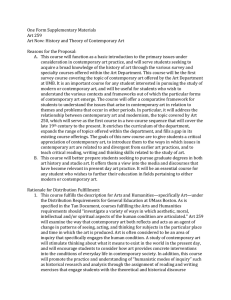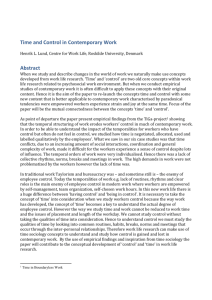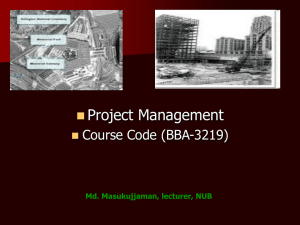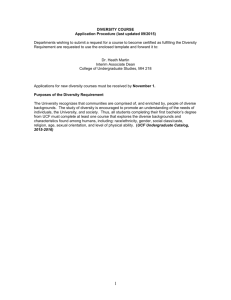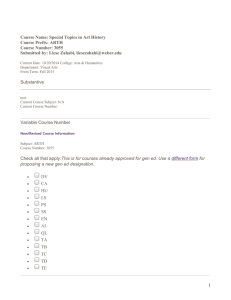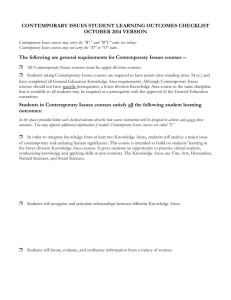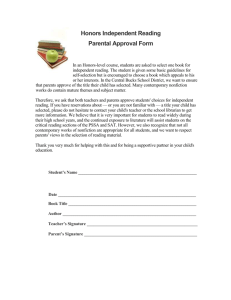Arts 259
advertisement
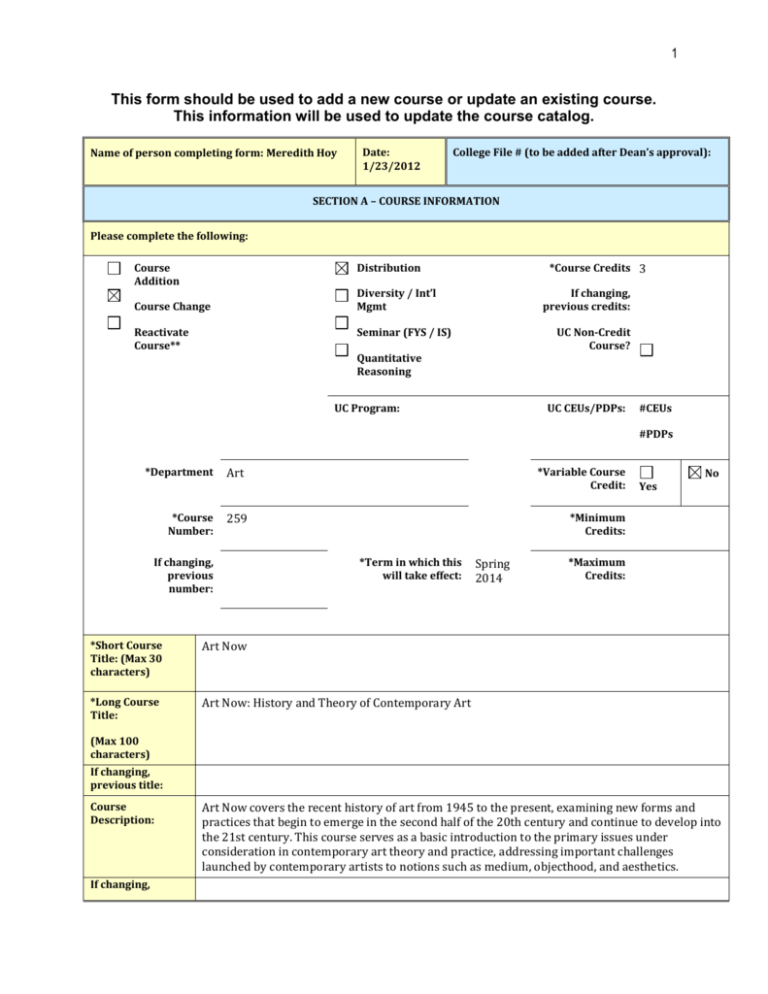
1 This form should be used to add a new course or update an existing course. This information will be used to update the course catalog. Name of person completing form: Meredith Hoy Date: 1/23/2012 College File # (to be added after Dean’s approval): SECTION A – COURSE INFORMATION Please complete the following: Course Addition Distribution *Course Credits 3 Diversity / Int’l Mgmt Course Change Reactivate Course** If changing, previous credits: UC Non-Credit Course? Seminar (FYS / IS) Quantitative Reasoning UC Program: UC CEUs/PDPs: #CEUs #PDPs *Department *Course Number: *Variable Course Credit: Art *Minimum Credits: 259 If changing, previous number: No Yes *Term in which this will take effect: *Short Course Title: (Max 30 characters) Art Now *Long Course Title: Art Now: History and Theory of Contemporary Art Spring 2014 *Maximum Credits: (Max 100 characters) If changing, previous title: Course Description: If changing, Art Now covers the recent history of art from 1945 to the present, examining new forms and practices that begin to emerge in the second half of the 20th century and continue to develop into the 21st century. This course serves as a basic introduction to the primary issues under consideration in contemporary art theory and practice, addressing important challenges launched by contemporary artists to notions such as medium, objecthood, and aesthetics. 2 previous description: Requisites (Please List All): If changes are being requested to co/prerequisites, please explain: Course Number Course Number Pre Co AND Pre Co AND Pre Co AND Pre Co AND Pre Co OR Pre Co Rationale for the Proposal: This course will be the second in a sequence, the first half of which covers modernism from Courbet to Pollock. Up to this point, the Art Department has not yet offered a survey course in contemporary art. This course is necessary for art students wishing to focus their studies on modern and contemporary art history, and will be useful for students to situate their own art practice in terms of existing varieties of art production within the contemporary art world. Other Information: ** “Reactivate Course” is intended to be used for courses that already exist but have been inactivated because they were not scheduled for five years or more. Departments wishing to reactivate such existing courses should send this form (including any minor changes in course description or title) and an updated syllabus to the Dean of their College. If the course is changing substantially, it should be submitted as a Course Change instead, following the normal governance process. 3 Course Offering Details (Please complete all of the following): *Course College (Academic Group): College of Liberal Arts *Course Department/Program (Subject) Art *Academic Career UGRD GRAD Is Course Cross Listed? Yes No NON-CREDIT If Course is Cross Listed, Complete the following: *Course College (Academic Group): No Cross-Listing Please note: cross listed courses should carry the same number in each cross listing department if at all possible. *Course Department (Subject) *Course Number (Catalog Number) *Cross Listed Career UGRD GRAD NON-CREDIT If course is cross-listed in more than two departments, please list additional departments and course numbers here: SECTION B – COURSE REQUIREMENTS Course Requirements (Undergraduate Courses): *Does this course fulfill a General Education Requirement? If Yes, please indicate the specific General Education Requirement. If this course is being submitted for Distribution, choose an area. If this course is being submitted for Diversity, choose an area. Yes No Distribution Arts (AR) None *Is this course a College of Management International Mgmt course? Yes No *Does this course fulfill a Major Requirement? Yes No If Yes, in what Major? Course Requirements (Graduate Courses): Art Note! If this is a NEW course, a separate request must be submitted for entry into Diversity, Quantitative Reasoning, or Distribution categories. 4 Is this course a Requirement? Elective? Is this course for a Doctoral program? Master’s program? Graduate Certificate? CAGS? What student population will be served by this course? % Undergrad 100 % Master’s % Certificate % Doctoral Other Course Information (Undergraduate and Graduate Courses): Is this course intended to be offered on-line? Yes No If yes, please consider the relevant Supplementary Information (see addendum) Has this course been offered as a Special Topics course? Yes No If yes, when? Fall 2011 5 SECTION C – OTHER COURSE INFORMATION Course Components (Please Check all that Apply): Hours/Week? Indicate the grading status of each component: Default Grading Basis (Please Check ONE ONLY): Component Primary? Lecture No No Graded? Yes No Graded Laboratory Yes Yes Graded? Yes No Pass/Fail Only Discussion Yes No Graded? Yes No Non Graded Indep Study Yes No Graded? Yes No Audit Field Studies No No Graded? Yes No Multi-Term (“Y”) Grad Research Yes Yes Graded? Yes No Sat/UnSat Clinical Yes No Graded? Yes No Competency Practicum Yes No Graded? Yes No Credit/No Credit Seminar Yes No Graded? Yes No Student Option Special Topics Yes Yes No No Graded? Yes No Other ___________ Graded? Yes No Studio Course Repeat Details Is Course Repeatable for Credit? Yes No Is a student allowed to enroll multiple times in a single term? Yes No Total Units Allowed (If Course can be Repeated for Credit) Total Completions Allowed (If Course can be Repeated for Credit) For Registrar’s Use Only Course ID: Course Entered By: Please Note: If a course is repeatable for credit, it cannot have Distribution status. 6 SECTION D - SIGNATURES Department: Art Number: 259 Course Title: Art Now: History and Theory of Contemporary Art Approval Signature Printed Name GPD Approval Date Approval Signature Printed Name Department Chair Approval Date Approval Signature Printed Name Collegiate Committee Approval Date Approval Signature Printed Name Collegiate Committee Approval Date Approval Signature Printed Name College Senate Chair Approval Date Approval Signature Printed Name College Dean Approval Date Approval Signature Printed Name PECC (if relevant) Approval Date Approval Signature Printed Name FC Subcommittee Approval Date Approval Signature Printed Name FC Committee Approval Date Approval Signature Printed Name AVP Undergrad. Studies Approval Date Approval Signature Printed Name Graduate Dean Approval Date Approval Signature Printed Name Chair, Faculty Council Approval Date Approval Signature Printed Name Provost Approval Date 7 SECTION E – SUPPLEMENTARY INFORMATION (DO NOT COPY WHEN SUBMITTING HARD COPY) Signatures Required (Please note: if more than one department or college is involved, be sure to get all relevant signatures) New or Amended UNDERGRADUATE course Department Chair, Chair of Collegiate Committee, Chair of Collegiate Senate or governing body, College Dean, Provost New or Amended GRADUATE course GPD, Department Chair, Chair of Collegiate Committee (if needed), PECC (if needed), College Dean, FC Grad Studies Committee Chair, Graduate Dean, FC Chair, Provost First-Year or Intermediate Seminar, Quantitative Reasoning Department Chair, Chair of Collegiate Committee, Chair of Collegiate Senate, College Dean, FC Subcommittee Chair, FC GenEd Committee Chair, AVP for Undergraduate Studies, FC Chair, Provost Distribution Status Department Chair, FC Subcommittee Chair, FC GenEd Committee Chair, AVP for Undergraduate Studies, FC Chair, Provost Diversity Status Department Chair, Diversity Chair, AAC Chair, Chair of Collegiate Senate, College Dean, Provost Supplementary Information Required 1 2 3 If this is a NEW course, please attach: If this is an AMENDED course, please attach: If this is an ONLINE course, please consider:1 a. A description of the reasons behind the proposal (how will the new course fit into the curriculum? What are the goals of the new course?) b. An indication of how the course serves students (its relationship to graduate, preprofessional or vocational objectives, and how it relates to other existing courses). c. A detailed syllabus, including principal topics covered in the course, an evaluation statement indicating ways in which you will evaluate students’ progress, and a brief bibliography. Please also include on the syllabus the following: a statement about accommodations for students with disabilities, and a statement regarding academic dishonesty and misconduct. (Sample statements are available upon request from the CLA/CSM Academic Affairs Committee.) a. A description of the reasons behind the proposal. b. An indication of how the course serves students (its relationship to graduate, preprofessional or vocational objectives, and how it relates to other existing courses). Recommended additional elements in syllabi for online course proposals: Instructor office hours: provide multiple options for students to contact instructor, e.g., face-to-face, telephone, e-mail, etc. Instructor bio recommended. Course description and course policies: include role of technology in the course, how the course is delivered, and whether this has the same pedagogical effect. Course objectives: include technology objectives if any. Prerequisites and required hardware, software, connectivity: include technology skill prerequisites. Include software, plug-ins, hardware, 8 connection and browser requirements. Grading policies and academic dishonesty: indicate grading strategies that will prevent student cheating. Communicate university policies for dealing with academic dishonesty. Group participation policies: Include clear expectations for group work and mechanisms and resources for monitoring. General syllabus and course calendar: include major topics, reading assignments, due dates, and exams. Organize by week. Adapted from Moore, G.; Winograd, K.; Lange, D. (2003). You Can Teach Online: Building a Creative Learning Environment. New York: McGraw Hill Custom Publishing. Unit 2, Lesson 9.17. Attendance, participation, and absenteeism: include expectations for student participation. Define absenteeism and establish expectations for student compliance. Exams: include procedures for exams in a controlled environment in accordance with university policies. E-mail procedures: establish expectations for the manner in which students are to identify themselves in e-mail messages. Campus presence: indicate when students must attend classes, labs, exams, advising sessions, and other events on campus or at other locations. The following apply to UNDERGRADUATE courses only: 9 4 If this course is being submitted as a First-Year or Intermediate SEMINAR, please attach: a. If the course is a FYS that will be counted towards the major/minor, please explain the rationale for granting major/minor credit. b. Will the department/program also offer a non-GenEd version of this course? If so, please indicate the title and course number. Be sure also to indicate clearly on course syllabi and other informational materials which course duplicates this seminar and may not be taken in addition to it. c. General seminar information: please include a paragraph near the beginning of the syllabus that tells students what the goals of the seminar are. Eligibility for entrance into an FYS or IS must be included in the syllabus. For First year Seminars, mention that there will be a mentor and an advisor attached to the course. Please emphasize that the FYS is 4 credits and incorporate the 4 th hour into your class plans as a regular part of the course, not an add-on labeled the "fourth hour". See sample seminar boilerplates available from the chair of the Seminars Assessment Committee related to all of this information. d. Questionnaire or statement indicating how and where you plan to address the GenEd Capabilities and assess student progress. You may use the Questionnaire distributed by the Seminars Assessment Committee or write a narrative using the guidelines for capabilities provided below. Intermediate Seminars must address at least three capabilities—Careful Reading, Clear Writing, and Critical Thinking. First Year Seminars must address those three plus Information Technology, Oral Presentation, Teamwork, and Academic Self Assessment. e. Sample assignments, indicating which capabilities they are designed to address. Among sample assignments, the Seminars Assessment Committee especially needs to see any assignments related to 5page WPE-type papers. f. In designing your course and preparing your proposal, you should refer to the following documents: "The General Education Capabilities Statements" (1997-98; Blue Document) and the "Guidelines for Level of Attention to Capabilities in First Year and Sophomore/Junior Seminars" (August 2002, Green Document). A description of the Mentor component is also available from the First Year Seminar Coordinator for those designing First Year Seminars. 10 5 If this course is being submitted for DISTRIBUTION status, please attach (each as a separate section): 1. Provide a rationale for inclusion in the proposed distribution area. How does the content of the course fit the definition and criteria of the proposed distribution area? (See the “Distribution Area Descriptions and Criteria for Course Content”, the Tan Document.) 2. Indicate whether students will have the opportunity to write a paper suitable for the Writing Proficiency Requirement Portfolio (an analytical paper of at least five pages dealing with two or more texts). If this is the case, please also include that information in your course description and syllabus. 3. Indicate which of the GenEd Capabilities will be covered in your course (at least two must be incorporated as an integral part of the course): Verbal Reasoning (Critical Thinking), Quantitative Reasoning, Critical Reading and Analysis, Effective Communication (Writing and/or Speaking), Use of Technology to Further Learning, Collaborative Work. Provide details on how the capabilities will be incorporated into the course. 4. Discuss the pedagogical methods, assignments, or class activities that will be used to ensure coverage of the area criteria and foster the attainment of the GenEd capabilities specified above. Also, please indicate how you will assess student progress and performance in meeting the goals of the course. 5. Syllabus: please include a paragraph near the beginning of the syllabus that tells students what the goals of the course are and which distribution area and capabilities the course covers. (We recommend including some form of the Area Definition as a “boilerplate” introduction to the distribution area.) 6. Provide a set of sample assignments, indicating which GenEd capabilities they are designed to address. 6 If this course is being submitted for QUANTITATIVE REASONING status, please attach: List the mathematical topics that this course will cover (required topics include: descriptive statistics, linear models, exponential models or probability, and the use of technology as in graphing calculators or computers). If your course deviates from this list, please explain the reason(s) for the deviation(s) and how your coverage will help the student achieve the educational principles listed below. Educational principles: Explain how this course imbeds the following basic principles of general education courses. Engage in critical reading and analysis Speak, listen, and write effectively. Reason logically and quantitatively. Use technology to further learning. Work independently and collaboratively. In particular, explain how this course will provide students with the opportunity to develop and demonstrate the capacity to: Recognize and pose real world problems involving the use and/or collection of data. Understand and critique quantitative arguments about real world problems. Formulate and communicate quantitative arguments and frameworks for decision-making. Use and make connections among the four standard modes of quantitative representations: oral/written, numerical, visual, and symbolic. Generalize and apply QR strategies to topics outside the course. Write quantitative arguments clearly and concisely. 11 On a separate sheet, explain how student capabilities will be assessed in this course. Furnish a course bibliography. 7 If this course is being submitted for DIVERSITY status, please attach: Indicate which of the elements of diversity will be covered in your course (at least two must be incorporated as an integral part of the course): Race, Gender, Class, Culture, Sexual Orientation, Age, and Disability. Provide a summary of how the course handles diversity as a central theme. Are there any particular pedagogical strategies that you use that explain how you handle diversity in your course? If so, please discuss any relevant teaching techniques, lecturing strategies, writing assignments, group work, films, etc. General Notes: Diversity courses may be offered in all areas and at all levels of the curriculum, and may use a variety of disciplinary and theoretical approaches. Courses can have either a US or more inclusive international focus (including courses that compare the US to other nations or world regions). If a proposed course is multi-sectioned, the department must agree to designate all sections as diversity courses, or else to separate diversity sections into a new course. Any course must have already achieved full governance approval as a regular academic offering before it can be considered for designation as a diversity course. END OF FORM 12 One Form Supplementary Materials Art 259 Art Now: History and Theory of Contemporary Art Reasons for the Proposal: A. This course will function as a basic introduction to the primary issues under consideration in contemporary art practice, and will serve students seeking to acquire a broad knowledge of the history of art through the various survey and specialty courses offered within the Art Department. This course will be the first survey course covering the topic of contemporary art offered by the Art Department at UMB. It is an important course for any student interested in pursuing the study of modern or contemporary art, and will be useful for students who wish to understand the various contexts and frameworks out of which the particular forms of contemporary art emerge. The course will offer a comparative framework for students to understand the issues that arise in contemporary art in relation to themes and problems that occur in other periods. In particular, it will address the relationship between contemporary art and modernism, the topic covered by Art 250, which will serve as the first course in a two-course sequence that will cover the late 19th century to the present. It enriches the curriculum of the department, expands the range of topics offered within the department, and fills a gap in its existing course offerings. The goals of this new course are to give students a critical appreciation of contemporary art, to introduce them to the ways in which issues in contemporary art are related to and divergent from earlier art practices, and to teach critical reading, writing and thinking skills related to the study of art. B. This course will better prepare students seeking to pursue graduate degrees in both art history and studio art. It offers them a view into the media and discourses that have become relevant in present day art practice. It will be an essential course for any student who wishes to further their education in fields pertaining to either modern or contemporary art. Rationale for Distribution Fulfillment: 1. This course fulfills the description for Arts and Humanities—specifically Art—under the Distribution Requirements for General Education at UMass Boston. As is specified in the Tan Document, courses fulfilling the Arts and Humanities requirements should “investigate a variety of ways in which aesthetic, moral, intellectual and/or spiritual aspects of the human condition are articulated.” Art 259 will examine the way that contemporary art both reflects and acts as an agent of change in patterns of seeing, acting, and thinking for subjects in the particular place and time in which the art is produced. Art is often considered to be an area of inquiry that specifically engages the human condition. A study of contemporary art will stimulate thinking about what it means to exist in the world in the present day, and will encourage students to consider how art provides concrete interventions into the conditions of everyday life in contemporary society. In addition, this course will promote the practice and understanding of “humanistic modes of inquiry” such as historical research and analysis through the assignment of reading and writing exercises that engage students with the theoretical and historical discourse 13 pertaining to contemporary art. Readings will foster students’ ability to critically engage with textual sources, while writing exercises will promote the development of coherent arguments that gather together and analyze both textual and visual material covered in the course. 2. Students will have an opportunity in this course to write a paper of sufficient analytical content, sources, and length to be submitted for the Writing Proficiency Requirement Portfolio. 3. General Education Capabilities covered in this course include Critical Reading and Analysis, and Effective Communication. a. Critical Reading: This course involves reading of textual sources that provide theoretical commentary on the works of art studied in the class. Lectures will directly incorporate these textual sources and demonstrate how to perform critical readings. Class discussions will allow students to practice their critical reading skills through close analysis of ideas contained within the reading. This course includes introductory sessions that discuss four of the important critical methodologies used in art historical analysis, including, for example, psychoanalysis and the social history of art. These sessions are designed to teach students what it means to think critically in an art historical context. The course will also involve assignments that ask students to formulate arguments on the basis of a well-developed thesis and critically engaged use of evidence. b. Effective Communication: Effective communication will be developed in this course through the incorporation of class discussion and written assignments. This will work to develop students’ skills in communicating orally as well as in written form. The number of written pages in this class will add up to 10-12 pages in accordance with the requirements for Effective Communication, including both in-class writing assignments in the form of blue book exams and a paper assignment to be completed out of class. One paper assigned for the course will meet the requirements to be submitted for the Writing Proficiency Portfolio. All graded papers will include written feedback from the professor. 4. The pedagogical methods that will be employed to ensure coverage of the Arts area of the Distribution requirements will focus primarily on students’ critical engagement with textual and visual sources. Lectures will be used to demonstrate the principles of verbal reasoning, critical reading, and effective communication, and class discussions will allow students to develop these skills for themselves. Written assignments will help them to translate their practice in making oral arguments into a more formal, written form. Students will be assessed in both areas of oral and written communication, and will receive regular feedback from the instructor on their progress in both areas. Assessment will be based on student’s ability to digest material presented in lecture/discussion as well as the assigned reading. They will be required to complete three blue book exams in which they will identify 10 images and then write two essays, either based on a given image comparison or on a more general question about themes presented in the course. Generalized questions will ask students to compare movements or periods in contemporary art history in order to demonstrate their understanding of lineages and precedents in the 14 development of different modes of art practice from 1945 to the present. Assessment will be based on students’ ability to produce a clearly structured pair of essays and their ability to provide relevant examples of artworks that fall within the time period or movement about which they are being questioned. The paper assignment for the course will require students to write a 5-6 page analysis of a work chosen from the Contemporary collection at a local museum and to contextualize it in terms of the historical moment in which it emerges and in relationship to other works produced by the same artist or works made within the same time period. Assessment will be based on students’ ability to construct a clear, linear argument with a distinct thesis and supporting evidence. 5. Syllabus: See attached 6. Sample Assignments: See attached (after syllabus) 15 Art 259 Art Now: History and Theory of Contemporary Art Spring 2014 MWF 9:00-9:50 McCormack Rm. 03-430 Professor Meredith Hoy Email: meredith.hoy@umb.edu Office: 458B McCormack Office Hours: MWF 10-11. To secure an appointment, please sign up for office hours on the sign-up sheet posted outside my office. Contact Info for Classmates (email and/or phone): Course Description: Art Now covers the recent history of contemporary art from 1945 to the present. Beginning with a review of the final years of modernism in the 20th century, this course examines new forms that begin to emerge after Abstract Expressionism and continue to develop into the 21st century. Over the course of the semester, the course will examine key works that demonstrate the conditions of contemporaneity in their given moment, taking into account that formal and conceptual signals of the contemporary will change over time. The course will consider the most important innovations, ideas, and questions raised by artists in the 20th and 21st centuries, including issues surrounding new technologies, site-specific works, installation, performance, land art, institutional critique, relational art, and even the 16 disappearance of the object altogether. In scrutinizing these topics, the course will address the role of the medium, the viewer, and the situational context in generating the “meaning” of the artwork, its construction of a network of relations between viewer, object, and environment, and its particular intervention or interventions into the history of art. Students will be expected to come to class prepared to discuss rigorously the material at hand. Each class session will combine readings from a survey textbook as well as secondary articles pertinent to the period in question. By the end of the semester, students are expected to produce a research paper on the topic of their choosing related to themes/issues in contemporary art. The course progresses chronologically, but each session will examine particular themes that arise in specific moments in the last half of the 20th century and the first years of the 21st, the relationship of these themes to one another and to the modernist traditions that are being expanded and reevaluated in contemporary culture. In accordance with the Art and Humanities Objective of the General Education requirements, Students will develop an informed appreciation of contemporary art, and will learn how people have come to understand and express “artistic, aesthetic, moral, spiritual, and philosophical dimensions of the human condition” through the specific issues, problems, and themes that arise through the study of contemporary art. Art 259 will examine the way that contemporary art both reflects and acts as an agent of change in patterns of seeing, acting, and thinking for subjects in the particular place and time in which the art is produced. Art is often considered to be an area of inquiry that specifically engages the human condition. A study of contemporary art will stimulate thinking about what it means to exist in the world in the present day, and will encourage students to consider how art provides concrete interventions into the conditions of everyday life in contemporary society. In addition, this course will promote the practice and understanding of “humanistic modes of inquiry” such as historical research and analysis through the assignment of reading and writing exercises that engage students with the theoretical and historical discourse pertaining to contemporary art. Readings will foster students’ ability to critically engage with textual sources, while writing exercises will promote the development of coherent arguments that gather together and analyze both textual and visual material covered in the course. In this class students will write a paper that may be submitted for the Writing Proficiency Requirement Portfolio. General Education Capabilities covered in this course include Critical Reading and Analysis, and Effective Communication. Critical Reading: This course involves reading of textual sources that provide theoretical commentary on the works of art studied in the class. Lectures will directly incorporate these textual sources and demonstrate how to perform critical readings. Class discussions will allow students to practice their critical reading skills through close analysis of ideas contained within the reading. Student progress will be assessed based on their ability to discuss course material cogently and incisively. The course will also involve assignments that ask students to formulate arguments on the basis of a well-developed thesis and critically engaged use of evidence. 17 Effective Communication: Effective communication will be developed in this course through the incorporation of class discussion and written assignments. This will work to develop students’ skills in communicating orally as well as in written form. The number of written pages in this class will add up to 10-12 pages in accordance with the requirements for Effective Communication, including both in-class writing assignments in the form of blue book exams and a paper assignment to be completed out of class. All graded papers will include written feedback from the professor. Course Requirements: Required Texts: H.H. Arnason and Elizabeth C Mansfield. History of Modern Art, Seventh Edition, Vol. II. Pearson, 2013. Kristine Stiles and Peter Selz. Theories and Documents of Contemporary Art: A Sourcebook of Artists’ Writings. Second Edition. University of California, 2012. Please note that all course readings not contained in these textbooks will be made available online via Wikispaces. Grading: Participation (Attendance, Discussion, Museum Visit): 10% Exam #1: 20% Exam #2: 20% Exam #3: 20% 5-6 pp Paper: 30% The following grading scale will be used: 100-93/A, 92-90/A-, 89-86/B+, 85-83/B, 8280/B-, 79-76/C+, 75-73/C, 72-70/C-, 69-66/D+, 65-63/D, 62-60/D-, 59 and lower/F. Please note that all assignments must be completed in order to pass the course. This includes students taking the course pass/fail. Plagiarism, cheating, or submission of 18 another person’s work is cause, without exception, for a failing grade and expulsion from the course. Assignments: Wiki: There will be a wiki page associated with this course, the URL for which will be https://art259-s14-hoy.wikspaces.umb.edu. I will post assignments, slide lists, and other notifications on the wiki as the need arises. Papers: There will be one paper assigned in the course. It will be a 5-6 pp research paper incorporating close analysis of an artist or artwork located in the Contemporary Wing of the MFA. For this assignment, students will gather and assess readings and artworks extending beyond the scope of assigned course materials. Assessment of this paper assignment will be based on students’ ability to construct a clear, linear argument with a specific thesis and supporting evidence for the initial claim. This paper will be of appropriate length for submission for the Writing Proficiency Exam portfolio. Late Papers: Papers are due at the beginning of class on the day they are due. Late papers will not be accepted. If you need an extension this must be worked out with me at least a week in advance of the due date. Emailed papers will not be accepted without prior approval. Exams: Students will be required to take three exams over the course of the semester. The format for all will be a bluebook exam, which will cover material from the readings, group discussion, and selected works of art. Please note that there will be no accommodations made for make-up exams. You must be present in class on the day the exam is given to receive credit. Reading: Please come to class having read the assignment for that day. You should be prepared to speak up about the reading—to offer your viewpoints and ask pertinent 19 questions. Recommended readings are not obligatory, but would help in adding to your depth of understanding of the required course material if you should choose to read them. In keeping with the Arts and Humanities general education requirements, this course involves reading of textual sources that provide theoretical commentary on the works of art studied in the class. Lectures will directly incorporate these textual sources and demonstrate how to perform critical readings. Class discussions will allow students to practice critical reading skills through close analysis of ideas contained within the reading. Participation: Attendance: Attendance is a requirement for taking and passing this course. I will take attendance at the beginning of each class. If you arrive after I finish taking attendance, you will be marked tardy. Three tardies equal one absence, and more than 3 unexcused absences during the semester will result in a failing grade for the participation portion of your grade. If you choose to leave early from class without arranging it in advance with me, you will be marked tardy. Discussion: Students are expected to come to class prepared to actively engage and speak up. I encourage students to respond not just to me but also to each other. Treat this class as a forum for group discussion and debate, as this will bring forth a greater depth and range of questions and topics related to the artworks and texts at hand. Each class meeting will include close analyses of the assigned texts and of artworks, the latter of which will include both works supplied by me and works proposed for discussion by students in the course. It is suggested that students supply, via email or directly to me in class, links to projects pertinent to topics discussed in this course. In accordance with the Arts and Humanities Distribution requirement, effective communication will be developed in this course through the incorporation of class discussion. This will work to develop students’ skills in communicating orally as well as in written form. Museum Visit: During the course of the semester, students will have the opportunity to visit the Museum of Fine Arts in Boston to see artworks related to the work we will discuss in class. Seeing digitized reproductions of artworks on the screen is no match for seeing them in person. Nuances that remain invisible in the slide format unfold when you observe the 20 artwork in its proper medium and context. For this reason, the museum visits are required and will be factored into your participation grade. A Note on Laptops and Cell Phones: ALL cell phones must be kept in bags or out of sight during class. If you need to take notes on something other than a laptop, please bring pen and paper. Laptops are to be used for note-taking purposes only. If I notice web-surfing or other recreation taking place during class I will be forced to ban laptops. While all of us engage in multi-tasking behaviors, we simply do not learn as effectively if we are shopping, chatting, or browsing in lecture. Accommodations: Section 504 of the Americans with Disabilities Act of 1990 offers guidelines for curriculum modifications and adaptations for students with documented disabilities. If applicable, students may obtain adaptation recommendations from the Ross Center for Disability Services, M-1-401, (617-287-7430). The student must present these recommendations and discuss them with each professor within a reasonable period, preferably by the end of Drop/Add period. Student Conduct and Academic Honesty: Students are required to adhere to the University Policy on Academic Standards and Cheating, to the University Statement on Plagiarism and the Documentation of Written Work, and to the Code of Student Conduct as delineated in the University Catalog and Student Handbook. The Code is available online at: http://www.umb.edu/life_on_campus/policies/code/. Violations of the code must be reported to the Chair of the Art Department. Writing Tutor: Several tutorial programs are offered at UMass Boston for assistance with writing skills. For information please visit Acadcemic Support Programs at http://www.academicsupport.umb.edu/ or Student Support Services at http://www.studentsupportservices.umb.edu/. Schedule of Classes (Subject to Change at Professor’s Discretion): 21 Week I: Background Monday, January 27 Intro, Hand Out Syllabus Wednesday, January 29 Arnason: xiii-xxii Friday, January 31 Arnason: xxiv-xxxi Week II: Gestural Abstraction Monday, February 3 Arnason: 377-384 Greenberg: “Modernist Painting” Wednesday, February 5 Arnason: 386-391 Rosenberg: “The American Action Painters” Friday, February 7 Selz and Stiles: 13-37 Week III: Color Field and Geometric Abstraction Monday, February 10 Arnason: pp. 392-400 Selz and Stiles: 77-91, 100-120, 124-132 Wednesday, February 12 In Class Film: The Cool School Friday, February 14 In Class Film: The Cool School 22 Week IV: Sculpture and Photography Monday, February 17 NO CLASS: PRESIDENT’S DAY HOLIDAY Wednesday, February 19 Arnason: 401-407 Selz and Stiles: 37-42, 601-602, 605-609 Friday, February 21 Arnason: 408-409, 442-443, 487, 526 Selz and Stiles: 790-791 Jeff Wall: “Frames of Reference” Week V: Postwar European Art Monday, February 24 Arnason: 411-422 Selz and Stiles: 210-211, 216-221 Wednesday, February 26 Arnason: 423-440 Selz and Stiles: 47-50, 54-56, 91-94, 243-245 Friday, February 28 Exam #1 Review Session Week VI: Nouveau Réalisme, Fluxus, Situtationism Monday, March 3 Exam #1 Wednesday, March 5 Arnason: 444-451 Selz and Stiles: 109-111, 327-329, 470-474, 614-623 23 Friday, March 7 Arnason: 452-454 Selz and Stiles: 800-803, 827-833, 848-851, 858-860 Week VII: Pop Culture and the 60’s Monday, March 10 Arnason: 456-464 Selz and Stiles: 236-243, 325-327, 331-334, 343-47, 373-378, 388-390 Wednesday, March 12 Arnason: 466-487 Selz and Stiles: 385-388, 833-838, 390-396 Allan Kaprow: “Happenings in the New York Scene” Friday, March 14 Arnason: 490-508 Selz and Stiles: 29-32, 133-136, 147-148, 453-454, 480-483, 647-648 Monday-Friday March 17-21 NO CLASS: SPRING BREAK! Week VIII: Minimalism Monday, March 24 Arnason: 510-526 Selz and Stiles: 128-131, 136-147, 149-150, 700-704, 688-689, 713-717 Wednesday, March 26 Michael Fried: “Art and Objecthood” Friday, March 28 24 Rosalind Krauss: “LeWitt in Progress” Selz and Stiles: 987-92 Week IX: Architecture, Conceptual, and Video Art Monday, March 31 Arnason: 527-557 Wednesday, April 2 Arnason: 558-566 Selz and Stiles: 161-169, 680-682, 955-970, 976-985, 992-997, 1002-1003, 10191031, 1040-1044 Friday, April 4 Arnason: 567-568 Selz and Stiles: 450-466, 494-499, 501-525, 717-720 Week X: Performance and Feminist Art Monday, April 7 Arnason: 558-586 Selz and Stiles: 799-820 Wednesday, April 9 NO CLASS: MFA Visit Friday, April 11 Exam #2 Review Session Week XI: Post-Minimalism, Earth Art, and the New Imagists Monday, April 14 Exam #2 Wednesday, April 16 25 Arnason: 587-595, 606-627 Selz and Stiles: 253-260, 279-281, 694-696, 779-783, 775-779, Friday, April 18 Arnason: 596-606 Robert Smithson: “Spiral Jetty,” “A Tour of the Monuments of Passaic,” “Cultural Confinement” Week XII: Postmodernism Monday, April 21 NO CLASS: PATRIOT’S DAY Wednesday, April 23 Arnason: 629-636 Selz and Stiles: 686-699 Friday, April 25 Arnason: 640-663 Selz and Stiles: 588-600 Week XIII: Painting Monday, April 28 Arnason: 666-676 Selz and Stiles: 191-201, 67-69, 359-363, 277-279, 281-283, 290-291 Wednesday, April 30 Rosemary Hawker: “Idiom Post-medium: Richter Painting Photography” Friday, May 2 Arnason: 680-692 Selz and Stiles: 67, 172-173, 266-272, 283-285, 339-340, 426-428, 432-435 NY Times Graffiti Articles 26 Week XIV: Art and Audience, Street Art Monday, May 5 Arnason: 695-713 Selz and Stiles: 525-529, 663-665 Wednesday, May 7 In Class Film: Beautiful Losers Friday, May 9 In Class Film: Beautiful Losers Week XV: Globalization Monday, May 12 Arnason: 729-759 Wednesday, May 14 Exam #3 Review Session 5-6 pp. paper due in class Final Exam: TBA 27 Sample Assignment A: Verbal Reasoning, Critical Reading, Effective Communication Art 310 Art Now Fall 2011 Professor Hoy ICA Response Paper Assignment: Due Thursday, October 13 2 pages, double spaced. 12 pt. Times New Roman, 1 inch margins. Please attach your ticket stub from your museum visit Any sources you use for additional information about this painting MUST BE CITED in proper MLA or Chicago format. To complete this assignment, please take a trip individually or in a group to the ICA Boston. Thursday nights from 5 to 9 pm the museum offers free admission to the public. Please select one or more works from either of the two exhibitions we will be touring as a class: Eva Hesse: Studiowork or Swoon: Anthropocene Extinction. Consider how these works relate to the issues we have been discussing concerning contemporary art. Some possible questions to contemplate and address in your paper include: How do these works intersect with or deviate from the modernist program of painting, as articulated by Greenberg? How do they relate to and or extend the notion of “painting”? What is their relationship to the notion of space—how do these works speak to or challenge the way that painting creates a sense of spatiality? What are these works trying to accomplish—how do they redefine the notion of the work of art as a unified, discrete object? What kinds of experience do these works activate? Before you start writing, use your preliminary answer to these questions, or a set of questions of your own devising, to formulate a distinct thesis: that is, a claim for which you must supply evidence and an argument to prove. In other words, your claim should not be of “the sky is blue” or “Hesse’s work is interesting” variety. The former is a truism, while the latter is too general and based on unfounded opinion to be of value to a potential 28 reader. You should point out not only that either Hesse’s or Swoon’s work is interesting, but engage more specifically with the question of how these works use specific mechanisms to advance their internal argument(s). Every artwork is making an implicit argument—it is your job to define and interpret how and why this argument is being made. What is the piece you have chosen trying to be “about,” and what devices does it use to telegraph what it is “about” to a viewer? Compose a 3-4 page essay that clearly states your claim and uses the body of the paper to prove that claim. The conclusion need not reiterate what you have already written, but should rather point to further conclusions or new ideas about these works and its larger social, political or aesthetic implications to which your essay might lead. 29 Sample Assignment B: Verbal Reasoning, Critical Reading, Effective Communication Art 310 Art Now Fall 2011 Professor Hoy Midterm Exam Please answer all questions in your bluebooks. Be sure to cite relevant textual sources in each of your answers. 1. Describe photoconceptualism. How does photoconceptualism demonstrate principles of Conceptual art? How is it similar to or different from other instances of Conceptual art? Name and discuss two practitioners of photoconceptualism and put them in dialogue with one example of non-photographic Conceptual art. 2. How does Partially Buried Woodshed (1970) intersect with and deviate from the notion of “sculpture” as it is traditionally understood? Name the term used by Smithson to describe the condition of contemporary sculpture and explain how it applies to this work. Name another example of contemporary sculpture that embodies this phenomenon in a different way than PBW, and discuss this difference. 3. How are the properties of Minimalism expressed by Donald Judd’s Untitled (Stack) (1967)? Identify and define at least three aspects of Minimalist art are deployed in this sculpture. List two ways in which David Smith’s Cubi XVII (1963) is unlike Minimalism, and thus how Minimalism deviates from high Modernist sculpture. 4. Explain how Barnett Newman’s Vir Heroicus Sublimis (1950-1) demonstrates the conditions of a) Abstract Expressionism and b) the Sublime. Discuss the similarities and differences between Newman’s approach to Abstract Expressionism and the formal and conceptual strategies employed by two other Abstract Expressionist painters. 30 Sample Assignment C: Verbal Reasoning, Critical Reading, Effective Communication Art Now Professor Hoy Research Paper Assignment 6-8 pages Double-spaced Times New Roman Due December 16, 2011 For this paper, please select a topic of your choosing that pertains to the study of contemporary art. You may choose to conduct your research on a particular artist, artwork, medium, theoretical idea, or a comparative study. You may cover a topic that we have addressed in class, or you may select a topic in which you are interested that was not within the focus of the course. When you have selected your topic, please email me with a brief proposal stating what your topic is to be, a preliminary thesis that you would like to argue, and a brief bibliography of sources (5-6 sources) that you plan to read for your research. I will approve your topic via email or suggest that you revise your topic before beginning your paper. In framing this paper, you want to make sure that you are introducing a specific claim that requires support to be proved. I am not looking for this paper to function as a report on the life of an artist, for example, but to propose an idea you have about that artist’s work and to follow up that idea in the form of a coherent, critically engaged argument. For your final paper, you must include a bibliography or works cited page that includes three scholarly sources. Any additional non-scholarly sources you use must be cited as well. All references must be properly cited in Chicago or MLA format.
